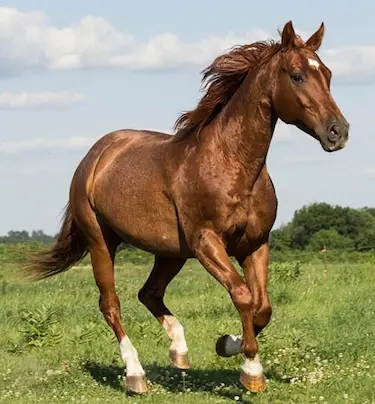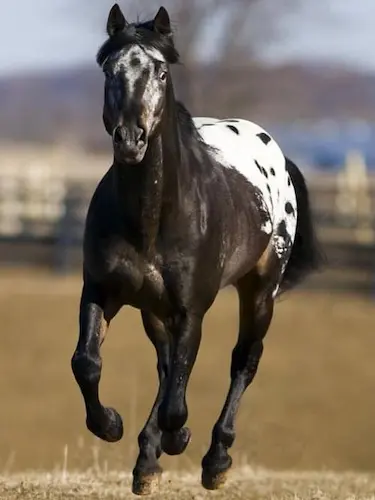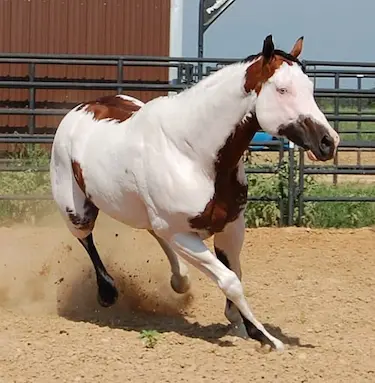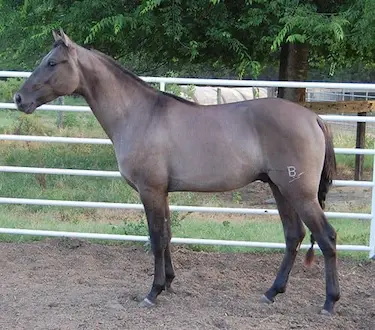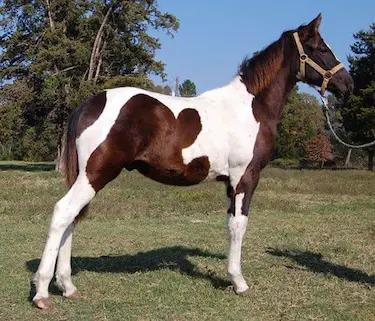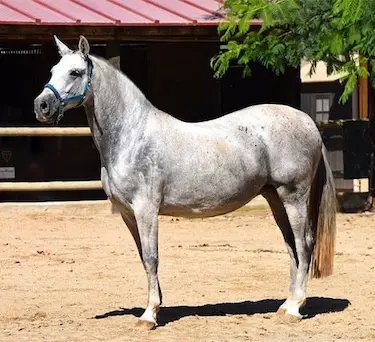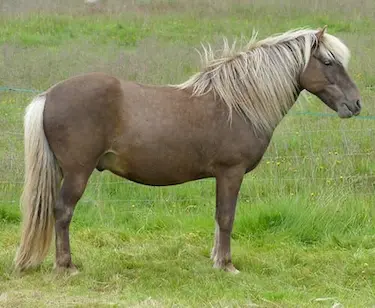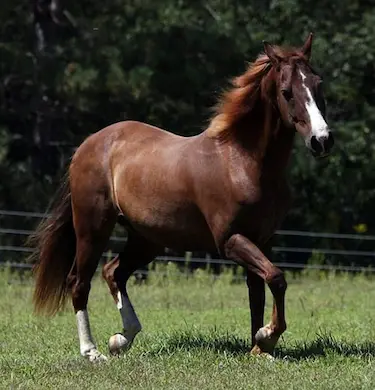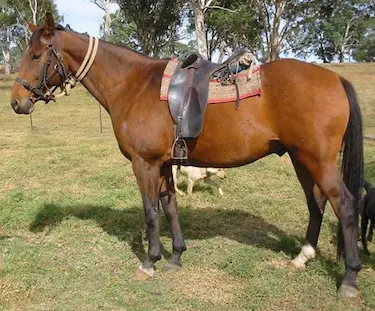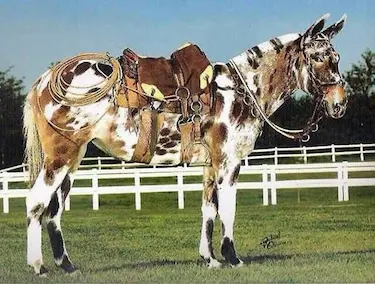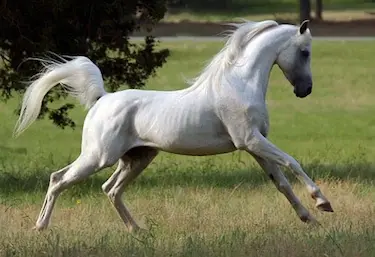Whether you’re a competitive trail rider or do it purely for pleasure you’ll know that there can be no better feeling than being sat on your favorite horse and enjoying the world as you pass through it, but what is it that makes a good trail horse? While there are certain characteristics, such as being sound and having the ability to get on with other horses, that are must-haves, there are some breeds that were pretty much born for the trail.
Before we look at which breeds are the best, what about those characteristics I mentioned a second ago? Of course, we all want our horses to be sound and get on with other horses but if you’re riding in a big group over uneven ground they’re an absolute must, but what other traits should we be looking out for? While I know that there will be people who disagree with what I say, for me at least, it’s important that a horse is sensible, yes he can be hot-headed but I don’t want a horse that is going to freak out every time he doesn’t like the shape of a rock or the way the branches look like they’re pointing at him.
What are the best trail riding breeds?
In this article, we’ll cover the top 11 best trail horses which are:
- Quarter Horse
- Appaloosa
- Paint Horse
- Tennessee Walker
- Spotted Saddle Horse
- Andalusian
- Icelandic Horse
- Morgan
- Australian Stock Horse
- Mule
- Arabian
What makes a good trail horse?
There’s no doubt that any horse can be used as a trail horse there are a few must-haves that they should all have. An ideal trail horse will be surefooted and able to cope with a range of different terrains, they should also be smooth and comfortable to ride. While the height of the horse may not seem important, having a horse that’s not too big can make your life easier if you have to mount and dismount a lot. Personally, I also think that the horse should have a sense of adventure and want to explore.
Gaited horses vs Non-Gaited Horses
It’s often said by riders of gaited horses, that because of the speed of their horses, they get to see far more of the scenery and cover a greater distance. People who ride non-gaited horses, on the other hand, will say that gaited riders go too fast to enjoy the scenery!
There’s no right or wrong with whether gaited or non-gaited horses make better trail rides, it’s all down to personal preference. Everybody has their own opinion on this and, as they are just that, they’re neither right nor wrong. They both have their own qualities that make them suited for the trail which is why I’ve included both of them in this article.
Quarter Horse
Height: No taller than 17hh (68 inches) but generally between 14hh (56 inches) and 16hh (64 inches)
Color: Sorrel is the most common but any color is allowed
Character: Quarter Horses are great all-round horses, they have a calm nature and plenty of energy
Country of Origin: USA
When you think of trail riding the likelihood is that the Quarter Horse is the first breed you think of, even if it’s ultimately not the breed you’d prefer, but it’s not by chance that it’s the first horse to spring to mind. They were originally bred for their speed but as the breed developed it evolved into a perfect cattle horse due to its natural cow sense. Since then a number of different ‘types’ have emerged depending on specific requirements, such as a cutting, reigning, or pleasure horse. The Quarter Horse has an immense amount of stamina, in part because it conserves its energy for when it’s needed.
Five things that make the Quarter Horse perfect for trail riders
- They’re known for their natural cow sense which means they won’t be nervous riding through herds of cattle
- They have plenty of energy but won’t use it all up on a whim, instead, they’ll save it for when it’s needed
- They have a great temperament and can be ridden and handled by adults and children alike
- They’re extremely sure-footed and aren’t likely to trip on uneven ground
- They’re intelligent horses and don’t spook look easily
Want to know more? Contact the American Quarter Horse Association.
Appaloosa
Height: Typically anything from 14hh (56 inches) to 16hh (64 inches)
Color: Mainly spotted although solid colored horses are allowed to be registered if they have mottle skin
Character: Appaloosas are extremely intelligent horses and are very loyal. They’re pretty much capable of doing anything
Country of Origin: USA
Originally bred by the Nez Percé Indians in the northwest of the states, the breed has always been prized for its speed, sure-footedness, and for its stamina. During the infamous Nez Percé war, the horses had to travel around 1,200 miles in just four months while also being used for fighting too, on top of that they had limited food and drink. The original Appaloosa was bred with other breeds, such as the Quarter Horse, Thoroughbred and Arabian to help increase its numbers. It’s the inclusion of Quarter Horse blood that has helped cement the Appaloosa’s place on the trail ride.
Five things that make the Appaloosa perfect for trail riders
- Appaloosas have all of the characteristics of the Quarter Horse with the added bonus of color!
- They’re very hardy horses that are happy being out in all weathers
- They have a great deal of stamina so can easily spend all day on the trail
- As well as being great on the trail they have a good jump so you can combine them if you want
- They’re always a talking point so you’ll never be short of things to talk about if you’re riding in a new group
Want to know more? Contact the Appaloosa Horse Club.
Paint Horse
Height: Ranging from 14.2hh (57 inches) to 15.2hh (61 inches)
Color: White along with any other color, the main coat patterns are tobiano (Sometimes referred to as toby, horses displaying the tobiano pattern will have white over their back and legs with their head being colored and their mane and tail having both white and color), overo (Overo horses have a white belly that rarely extends over their back, they also tend to have white heads with one or both eyes being blue) and tovero (The tovero pattern is a mixture of both the tobiano and over patterns)
Character: The Paint Horse has a friendly nature, they’re known for their intelligence and relax disposition
Country of Origin: USA
All Paint Horses are pureblood Paints or have a parent that’s registered with either the American Quarter Horse Association (AQHA) or the Thoroughbred’s register (known as the Jockey Club) which is one of the reasons why it’s such a great trail horse. As you would expect it has all of the characteristics of the Quarter Horse (in fact a large number of Paint Horses are double registered with the AQHA) as well as the speed of the Thoroughbred which is why, to a lot of people, its the perfect trail horse.
Five things that make the Paint Horse perfect for trail riders
- They’re patient horses that don’t get spooked easily
- They’re more than capable of thinking for themselves but are happy to be lead
- Like The Appaloosa, their striking coat patterns make them a great talking point
- They’re comfortable to ride and don’t often stumble of rough terrain
- A lot of Paint Horses are double registered with the American Quarter Horse Association so have all the qualities of a Quarter Horse
Want to know more? Contact the American Paint Horse Association.
Tennessee Walker
Height: Most stand between 14.3hh (57 inches) and 17hh (68 inches)
Color: Any color
Character: The Tennessee Walker is a very placid horse that is known for its versatility as well as its smooth gait
Country of Origin: USA
Gaited horses are very popular on the trail and when you consider how comfortable they are to ride it’s easy to see why. When it comes to the trail the Tennessee Walker is, without doubt, the most popular of all gaited breeds. It was originally bred for the duel purpose of inspecting the plantations during the day and pulling the family carriage by night. While they’re not used in harness as much these days they are still valued for their comfortable gaits as well as their speed. It’s said that they glide over the ground and that the rider feels as if they’re floating – if you’re spending all day in the saddle what more could you ask for!
Five things that make the Tennessee Walker perfect for trail riders
- They can cover a lot of ground very quickly without tiring
- They have a calm temperament and aren’t prone to spooking
- They’re friendly horses that can easily be handled by both adults and children
- They have a ‘rocking chair’ movement that is unbelievably comfortable to ride
- Having been bred to be ridden during the day and driven in the evening they have plenty of stamina
Want to know more? Contact the Tennessee Walking Horse Breeders’ & Exhibitors’ Association.
Spotted Saddle Horse
Height: Generally between 14.3hh (57 inches) and 16hh (64 inches)
Color: Pinto, which, like the Paint Horse, means they must be white with any other color in either a tobiano, overo or tovero pattern
Character: The Spotted Saddle Horse has a very friendly personality and is known for its levelheadedness
Country of Origin: USA
The only two requirements for horses to be registered are that they have the pinto coloring and have an ambling gait which is why a lot of Spotted Saddle Horses are duel registered as Missouri Foxtrotters, Tennessee Walkers, or American Saddlebreds. It’s this ambling gait, along with their temperament and athletic ability that makes them such a great trail horse.
Five things that make the Spotted Saddle Horse perfect for trail riders
- They’re great horses that are perfect for all riders, regardless of their ability
- They’re gaited horses so have a very comfortable ride that won’t tire the horse or the rider
- They’re friendly horses that are said to be as gentle as anything but have the courage of a lion
- They’re surefooted but not over cautious so aren’t likely to slip but won’t waste time thinking about every step
- They love to be around people and are easy to train
Want to know more? Contact the National Spotted Saddle Horse Association.
Andalusian
Height: Mares should be at least 14.3hh (57 inches) while stallions shouldn’t be shorter than 15.2hh (61 inches), they’re generally no taller than 16.2hh (64 inches)
Color: Gray and bay are the most common but black, chestnut, palomino, and dun are also found
Character: The Andalusian’s obedience combined with their intelligence makes them very easy to train
Country of Origin: Spain
Due to its history and wide use within the classic dressage arena, the Andalusian isn’t necessarily the first breed you think of when looking for a good trail horse, but it’s actually a very popular stock horse. It was originally bred as a stock horse to work with the region’s aggressive Iberian bulls, which they do without complaint and without being unnerved. It’s this, along with their willingness to turn their hoof to anything, that makes them a perfect, even if somewhat unusual, choice for the trail
Five things that make the Andalusian perfect for trail riders
- They’re very athletic and, in the past were expected, from the age of 5 to be able to gallop for at least 12 miles without stopping
- They’re very calm and won’t panic if you’re faced with a cougar or other predator
- They have long strides which make them a very comfortable ride on the trail
- They’re very hardy and have a lot of endurance
- They’re willing horses that will happily do what you ask them to do and go where you ask
Want to know more? Contact the International Andalusian & Lusitano Horse Association.
Icelandic Horse
Height: Typically anything between 13hh (52 inches) and 14hh (56 inches)
Color: Solid colors are more common but they can be any color
Character: Icelandic Horses are tough little horses that are friendly and comfortable to ride
Country of Origin: Iceland
Even today they are still used to round up livestock a lot in Iceland so have to spend long days being ridden over rough, uneven, and sometimes frozen ground. They do this happily without tiring and often with plenty of energy left to spare. They also have their own inbuilt homing device which allows them to find their own way home – perfect if you’re exhausted after a long ride.
Five things that make the Icelandic Horse perfect for trail riders
- They have no predators in their native Iceland so will assess something rather than spook at it
- Despite their size, they’re extremely strong horses that can carry most riders
- Their comfortable gaits can be very fast so there’s no problem with them keeping up with much bigger horses
- They can be ridden for days on end without tiring, which is great if your thinking of riding a great distance
- They’re extremely hardy and, in the winter, grow an extra layer to their coat which helps to keep the snow and cold out.
Want to know more? Contact the Horses of Iceland.
Morgan
Height: Normally anything between 14hh (56 inches) and 15.2hh (62 inches)
Color: Any color although chestnut, black, brown, and bay are the most common
Character: A brave and courageous breed that is very strong in relation to its size
Country of Origin: USA
When you consider that the Morgan has played a role in the development of some of the best trail breeds such as the Quarter Horse and the Tennessee Walker it’s no surprise that it makes a great trail horse itself. They’re very strong horses that can carry (and pull) a great deal of weight over a long distance. In fact, the very first Morgan, a horse known as Figure, could pull over 400lb and was so fast he was never beaten over a quarter of a mile.
Five things that make the Morgan perfect for trail riders
- They’re strong horses that can carry a lot more weight than you might think they’re capable of
- They’re a highly intelligent breed that is confident and full of personality
- Some Morgans are gaited which means that they’re perfect for people on both sides of the gaited/non-gaited fence
- They’re versatile horses and are just as happy on the trail as they are in any other discipline, regardless of whether it’s English or Western
- They’re willing horses that are said to have a great sense of humor on the trail
Want to know more? Contact the American Morgan Association.
Australian Stock Horse
Height: Most horses stand between 14hh (56 inches) and 16.2hh (66 inches)
Color: Any color
Character: Originally being used to work cattle the Australian Stock Horse has a calm temperament while at the same time being courageous and possessing a great deal of stamina
Country of Origin: Australia
Having been bred to cope with all of Australia’s conditions, both in terms of climate and terrain, the Australian Stock Horse really is a breed for every need. Still used as a workhorse it’s also valued as a versatile horse that excels in every discipline in part takes in. In Australia, they’re mainly ridden in the Australian stock style which is very similar to the Western style. They’re often a bit leaner than Quarter Horses but are occasionally referred to as Australian Quarter Horses.
Five things that make the Australian Stock Horse perfect for trail riders
- They’re very agile and athletic horses that also have a lot of stamina
- They’re extremely surefooted and are known for their soundness
- In Australia, they’re still used to round up cattle in mountainous terrain so are happy on any ground
- They’re highly intelligent and have very willing temperaments
- Although it was controversial, a lot of Quarter Horse was introduced so they also have the qualities of them too
Want to know more? Contact the Australian Stock Horse Society.
Mule
Height: They have a wide height range and can be anything between 12hh (50 inches) and 17.5hh (70 inches)
Color: Any color although sorrel, bay, black, and grey are the most common
Character: Mules are said to be more intelligent than most horses and donkeys, they also have a friendly nature and are naturally cautious
Mules are becoming far more popular with trail riders these days and when you consider that for centuries they’ve been used to carry people (and all of their luggage) over rough, uneven, and even dangerous terrain it’s easy to see why. Being the offspring of a male donkey and a female horse they have the best characteristics of both, although they are said to be more intelligent than either of their parents.
Five things that make the Mule perfect for trail riders
- They’re known for their toughness as well as their sure-footedness and endurance
- They have far more stamina than a lot of horse breeds
- They’re capable of carrying a lot more weight than you might think, they can happily carry around 20% of their body weight
- Their skin is tougher than that of a horse so are less likely to suffer any scratches or scrapes
- They’re still used over terrain that vehicles can’t manage which makes them a great choice over a rough and uneven trail
Want to know more? Contact the American Mules Association.
Arabian
Height: Typically between 14.1hh (56 inches) and 15.1hh (60 inches)
Color: Bay, grey, chestnut, black or roan
Character: Despite having a reputation for being highly strung they actually make very good family horses due to their kind and calm nature
Country of Origin: Arabian peninsula
Some people will argue that the Arabian is too spirited to be used as a trail horse but this is largely due to the individual horse rather than the breed as a whole. Yes, there are, of course, plenty of highly-strung Arabians but there are also just as many that aren’t which is why I don’t think it should be a consideration. As a rule, Arabians have the strength, endurance, intelligence, and energy to make great trail horses.
Five things that make the Arabian perfect for trail riders
- They are very popular in endurance riding so won’t tire easily
- They love being around people and are known for their loyalty
- Due to their desert background, they can survive with less water than most other breeds can
- They were originally bred for their speed and endurance as well as their intelligence
- They’re surefooted and tend to move quietly too
Want to know more? Contact the Arabian Horse Association.
Further reading
If you’re interested in trail riding then you may find this article on essential trail accessories helpful, likewise if you regularly ride with gloves you should check out my guide to the ultimate riding gloves.
If, on the other hand, you want to know more about different horse breeds then you should check out my articles on the best endurance breeds, as well as the fastest horses, or if that’s not enough for you I have even more breed related content.
I hope you found this article helpful. If you did I’d be grateful if you could share it please as it would really help me.
Recommended products
Over the years I have tried hundreds of different horsey products, from various blankets and halters to different treats. Some I’ve loved, others I’ve hated but I thought I’d share with you my top all-time favorite products, the ones I never leave the yard without. I’ve included links to the products (which are in no particular order) that I really think are great.
- Horse Knots by Reference Ready – If you’re like me and enjoy pocket reference guides then you’ll love this knot tying guide. These handy cards can easily fit in your pocket or attach to the saddle for quick reference. They’re waterproof, durable and are color coded to make them easy to follow.
- Mane ’n Tail Detangler – Even if you never show your horse you’ll need to detangle his tail from time to time (and possibly his mane too) which is always a challenging chore! I’ve found that if I run a little bit of detangler through my horse’s tails every few days it stops them from getting matted up and makes combing them easy, even if they’re coated in mud. I don’t know if I should admit to this or not but it also works wonders on my hair.
- TAKEKIT Pro clippers – Over the years I’ve tried a lot of different clippers and while some were obviously better than others I found these to be by far the best. They are heavier than a lot of other clippers but for me, that’s a good thing, it makes them feel more sturdy and hardwearing. On top of that they have a range of speeds so are just as good for clipping your horse’s back as they are his face. I also like the fact that they come in a handy carry case but that’s not for everybody. The company that makes them is super good and incredibly helpful too, a real bonus these days. The only thing I wasn’t keen on was the fact that it doesn’t come with any oil, but that’s not a major problem as it’s not difficult to buy lubricant.
- Shire’s ball feeder – There are so many boredom buster toys out there but I like to use these every day, regardless of whether or not my horses are bored. I find that it helps to encourage my horses to problem solve by rewarding them with treats (or pieces of fruit) but it also mimics their natural grazing behavior which helps to keep them calm and de-stressed.
- Horse safe mirror – This is a strange one that many people are surprised about but I like to put horse safe mirrors in the trailers as well as in the quarantine stalls. It helps to prevent the feeling of isolation by giving the impression of other horses being around. Being herd animals horses can get extremely stressed when they feel that they’re on their own but with these stick-on mirrors, they believe that at least one other horse is with them.
- Rectal thermometer – I know this isn’t glamourous at all but it’s vital for your horse’s well-being to be able to check their temperature and a rectal thermometer is the easiest way of doing this which is why I’ve added it to the list.
Shopping lists
I’ve also put together a few shopping lists of essential items that I’ve found helpful over the years. I’ve broken the lists down into different categories rather than put everything in one massive list 😉

